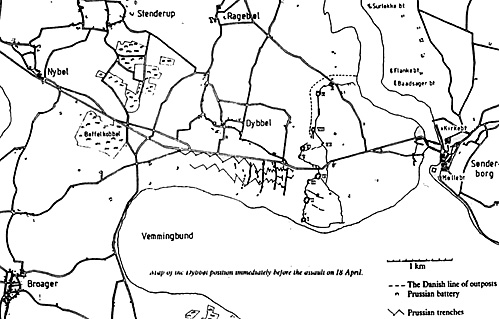The Dannevirke and Dybbol (Duppel) fortifications were the main defense lines that the Danish army fell back on during the 1864 war with Prussia and Austria. The Dannevirke was built in the 1840's as a light field fortification with modest works before the first Prussian-Danish War (the Schleswig-Holstein Revolt).
In 1853, a military commission proposed that the defense of the Jutland Peninsula should be based on forts at the flanks of Dybbol (in the vicinity of the island of Alsen) and to the North at Fredreica. See Map 1. The Dannevirke would serve as a secondary line of defense. The Dannevirke ran East and West in the disputed duchy of Schleswig. The main advantage of strong flank positions at Dybbol and Fredreica would be that the Danish Navy could provide artillery support and evacuate troops by sea if necessary if the Dannevirke was attacked.
The commission decided on three huge forts and some smaller works at Dybbol with five smaller forts located by Sonderborg on the island of Alsen. The fortress at Fredericia would be extended by building five advanced forts in addition to twelve bastions.
However, this proposal was rejected due to cost. Denmark was trying to save on military expenditures during this period by demobilizing the army and limiting the training. This is one of the main reasons why Denmark lost to Prussia in 1864. For the following eight years, nothing was done.
In 1861, the politicians realized the importance of defending against Prussia and that the old Dannevirke should be the cornerstone of the defense. Fortifications in the flank positions were abandoned and a fifteen-kilometer long Dannevirke earthwork was dug. The left flank of this line was secured by the Slien estuary and the marshes of Frederick Stadtin and the right flank by swamps and flooded areas from Hollingsted to the West Coast. The Danish army had 600 fortress-caliber guns. The army placed 175 of them at Dybbol,100 on the island of Alsen and 260 at Fredericia.
The Danish army calculated it would take 60,000 men to defend the Dannevirke and the forts. To prevent the Prussians from outflanking the Dannevirke, the army wanted to build new works at Mysunde. However by 1864 when the war began, the Danish army only had 38,000 men to man the Dannevirke, the works were not added at Mysunde and if Prussia attacked during the winter, they could easily cross the swamps and flooded areas flanking the Dannevirke.
Unfortunately, Prussia did attack in the winter of 1864 due to Denmark adopting a new constitution in 1863 that incorporated the disputed and pro-Prussian duchies of Schleswig and Holstein into Denmark.
When the war started, the Dybbol position consisted of ten small half-finished earthworks in a three-kilometer curve. Danish Army units that retreated from the Austrian attacks on the Dannevirke arrived at Dybbol on February 7. The Danish troops began to immediately improve the positions by arming the earthworks, digging trenches and fabricating obstacles well into March.
By the time of the Prussian attacks in March, the Dybbol position consisted of four separate concentric lines. See Map 2. The first line was a narrow defile between two hills that was protected by a double row of palisades flanked on each side by a half battery. One half-mile further inland was the second line. This line consisted of ten earthwork forts connected by trenches based around Duppel Hill. The third line depended more on natural terrain features and consisted of the wide slopes and the crest of the Avnjerg, the village of Dybbol and broken ground in the vicinity of Ragebol. The fourth and final line was two miles from the Sonderburg bridges (connecting to the island of Alsen) and ran from the woods of Stenterupskov and Boffel Kobbel.
On April 18, 1864, the Prussians assaulted the Dybbol forts after a six hour long massive artillery bombardment. The already battered positions were reduced to rubble and had provided little cover to the defending troops. Denmark had roughly 5000 men defending the works with a further 6000 troops in reserve. They suffered 808 dead, 909 wounded, 2872 prisoners and 215 missing for a total of 4804 casualties. The Prussians suffered 1200 casualties out of 37,000 troops.
Denmark still fought on until Prussia assaulted Alsen. Peace talks started on August 1. Denmark suffered little considering that most of the country was occupied. She gave up control of the duchies of Schleswig and Holstein and made reparation payments to Prussia.
If Denmark didn't cut military spending, it is quite possible that she could have a fought a decisive battle and triggered foreign intervention. As a testimony to the courage of the Danish troops defending against the Prussian assault, every April 18 is remembered in Denmark. Part of the original sight is preserved and a museum is there for those to see.
Map

Dannevirke and Dybbol Fortifications: Jumbo Map (slow: 115K)
Back to Clash of Empires No. 5/6 Table of Contents
Back to Clash of Empires List of Issues
Back to Master Magazine List
© Copyright 1999 by Keith Frye
This article appears in MagWeb (Magazine Web) on the Internet World Wide Web.
Other military history articles and gaming articles are available at http://www.magweb.com